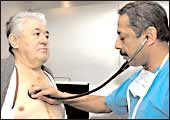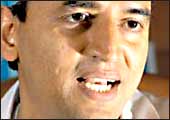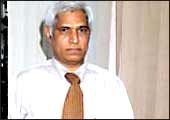 |
| Finger on the pulse: An
Uzbek patient with Escorts' Dr Trehan |
Convalescing
after his open-heart surgery at Delhi's Escorts Heart Institute
and Research Centre (EHIRC), B. S. Sayitkulov (62) from Tashkent
(Uzbekistan) is as happy as happy can be. He tells his son, who
can speak English, to tell this writer that he has been to Russia,
North America and many countries of western Europe on business
trips and knows a lot about heartcare facilities there. "But
doctors, surgeons and nurses in India are the most professional
in the world. I could not have received the treatment and care
I got at Escorts in Moscow or London," says Sayitkulov, as
he is wheeled from his second-floor room to the first-floor room
of Dr Naresh Trehan, the founder and Executive Director of EHIRC,
and India's poster-boy for cardiology. At the doctor's room, Sayitkulov
adds to his gratitude by suggesting that Escorts should consider
setting up an hospital in Uzbekistan. "Life-saving heartcare
is just one of the many comparative advantages India has,"
says Dr Trehan. "Today, the entire SAARC region, Afghanistan
and CIS countries look at India as a destination for cardiology,
orthopaedics, cosmetic treatments, eyecare, dentistry and other
specialties."
Various studies, starting with CII-McKinsey's
in 2001, have put India's medical tourism (nowadays called medical
value travel) potential between $1.48 billion (FICCI-E&Y projection)
and $2 billion (CII-McKinsey) by 2012, accounting for 3-5 per
cent of the total healthcare delivery market. "India received
close to 2 lakh foreign patients in 2006 and IHCF (Indian Healthcare
Federation, an industry association) members earned revenues of
about $335 million," says Vishal Bali, CEO, Wockhardt Hospitals.
"There is 30-35 per cent year-on-year growth in number of
foreign patient arrivals. So, I think we can reach the $2 billion
target in 2010," he says.
 |
| Dr Devi Prasad Shetty's
Narayana Hrudayalaya has become a global destination for paediatric
heart surgeries |
Wockhardt, which has eight hospitals across
India and many more in the pipeline, treated 2,000 foreign patients,
80 per cent of whom were from the us and the UK. Most of these
patients were here for high-end procedures such as coronary angiography,
angioplasty and stenting, brain surgery for abnormal blood vessels,
corrective skull surgeries, and neuro-muscular disorders, among
others.
Fortis Healthcare, which now controls EHIRC
and other Escorts hospitals, logs an average of 400 foreign patients
a month in its dozen facilities, a majority of them from the developing
countries, but a growing number from the developed world, says
Daljit Singh, President (Strategy and Organisational Development).
Fortis plans to have 35-40 hospitals by 2010, with primary focus
on the domestic market, but with the medical tourist in mind as
well.
In Bangalore, Dr. Devi Prasad Shetty's Narayana
Hriduyalaya has become a global destination for paediatric heart
surgeries. "There are more than 30 IHCF members, including
Apollo, Wockhardt, Fortis and Max, which we are vigorously promoting
in international markets, particularly the us, the UK, and West
Asia," notes Amitabh Kant, Joint Secretary, Ministry of Tourism.
"We have made these entities adhere to uniform price banding
and standards of medical healthcare so that we can promote Indian
healthcare as a quality-benchmarked industry," says Kant,
who is better known as the prime mover behind the Incredible India
campaign.
Value Healthcare
 |
| In safe hands: Tanzanian
patients at a Care hospital |
So what's India's trump card versus the developed
countries and rival healthcare destinations like Thailand and
Singapore? "A cardiac procedure costs anywhere between $40,000
and $60,000 in the us, $30,000 in Singapore, $12,000-15,000 in
Thailand and only $3,000-6,000 in India. The associated costs
of surgery are also low," says the FICCI-E&Y study. The
overall success rate of cardiac bypasses in India is said to be
98.7 per cent, compared to 97.5 per cent in the US, says the same
study. "Indian healthcare is no longer about only the cost
differential; it's about the value differential," says Bali.
"Today we offer life-saving therapies to the world, from
heart surgeries to minimally invasive neuro-surgeries.
In eyecare, for example, India has state-of-the-art
facilities such as Sankara Nethralaya in Chennai, Aravind Eye
Hospital in Madurai and LV Prasad Eye Institute in Hyderabad.
"In ophthalmology, I can say with confidence that our facilities
and therapies are as good as those of the developed world. Moreover,
our pricing doesn't discriminate between Indian and foreign patients,"
says Dr Lingam Gopal, Chairman-elect of non-profit Sankara Nethralaya,
whose 265-bed facilities in Chennai and Kolkata attracted about
5,000 foreign patients in the first half of 2006.
Bali says the presence of 61 million people
with no health insurance in the us, overstretched National Health
Service (NHS) in the UK and, more generally, a greying population
in the West are "natural" opportunities for India, given
the huge cost advantage that it has and the prestige that Indian
clinicians enjoy in the Western countries. The government-IHCF
team has a strategic focus on the developed world. The logic:
if you can attract the Americans and the Britons, you can attract
anyone in the world.
 |
| Dr Gopal's Sankara Nethralaya
treated 5,000 foreign patients in the first half of 2006 at
its Kolkata and Chennai centres |
Trehan points out that Indian healthcare providers
are already seeking tie-ups with health insurance companies in
the developed world. "Very soon you will see insurers in
|



